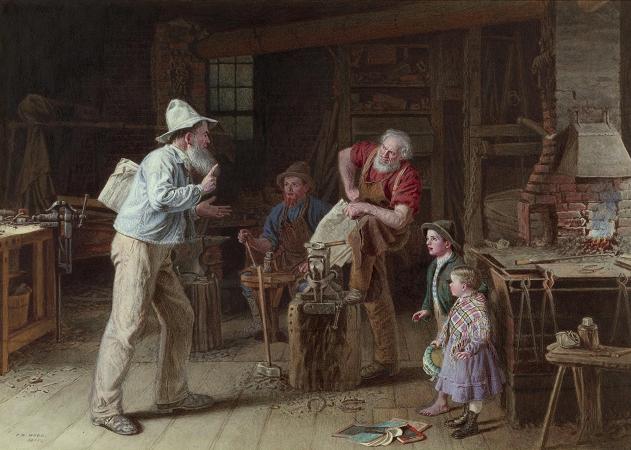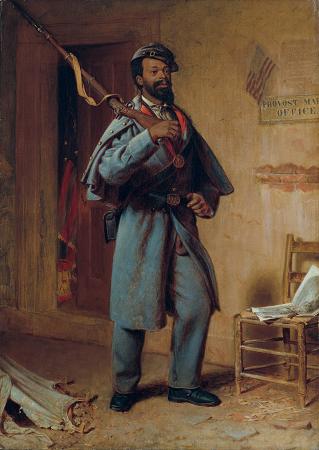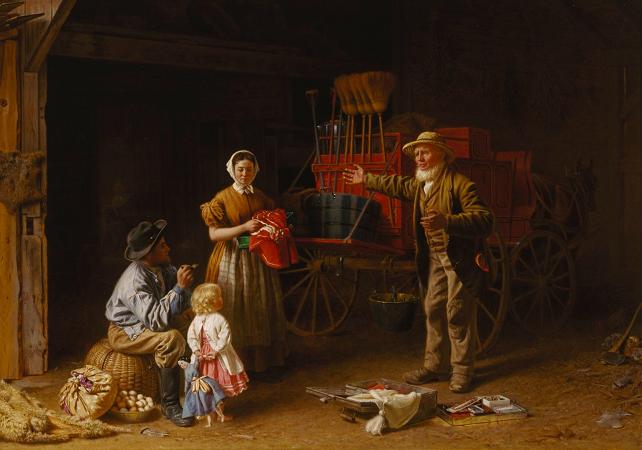Thomas Waterman Wood (1823 - 1903). Thomas Waterman Wood was an American painter born in Montpelier, Vermont. Thomas Waterman Wood's father, John Wood, came to Montpelier from Lebanon, New Hampshire in 1814. The Wood family was of Puritan descent, and it was from Lebanon that John Wood, the father of the artist, married his wife Mary Waterman. She was described as having lived a simple, pious, good-natured and industrious life. John Wood and his brother Cyrus were partners in a cabinet making business, the partnership concluding with the death of Cyrus in 1840. John's other brother, Zenas, lived to be 84 years of age. John Wood was a vigorous citizen, active in his times, the captain of an artillery company and for a long time, a deacon in the First Congregational Church. During Wood's youth, Montpelier was not likely to inspire a man to paint. It was a small town of practical people, lacking in the means of art culture and instruction in art. The hills and valleys, however, were beautiful, filled at all seasons with a wonderful light, and these had and continued to have for Wood an inspiration and influence throughout his life. While he lacked artistic surroundings in his youth, he also had the acquaintance of great contemporaries, Prentiss, Upham, Spaulding, Peck, Reed, Walton, Jewett, Langdon, Merrill, Dewey, Thompson, Baileys, Heaton, Lord, Lamb and many more besides, who left notable records in Congress, on the bench, at the bar, in theology, finance, legislation, party politics and in the bibliography of Vermont. These neighbors of his were good, strong men, whose characters and excelling work influenced the youth of Wood as also his conceptions of a strong art, as was evidenced in later years by much of his best work. Before the introduction of daguerreotypes Montpelier was accustomed to receive an occasional visit from some peripatetic portrait painter and it was such a painter who first influenced Wood and started him in his career. The painter has been described as a harum-scarum character, but also as a dashing painter, who was able to seize quickly and firmly upon a likeness. There was also a friend, John C. Badger, who brought from Boston tubes of oil colors, brushes, palettes and some books about art. With these in hand the boys began with enthusiasm to develop their resources. There remains nothing of these first efforts; but when the furniture shop of John Wood was destroyed by fire in 1875 there could yet be seen on its plastered walls a number of figure pictures, drawn with dry paints, a sort of rude pastel. When fortune permitted, Wood went to Boston and studied for a short time in the studio of Chester Harding, a portrait painter. In 1850 he married Miss Minerva Robinson, then living in Waterbury, Vermont, and in the same year he built a summer home in the Carpenter Gothic style on the west side of the mountain gorge through which the road leads up to Northfield. He named this home after his wife, making use of the Latin synonym, Athenwood. During the 1850s, he found means of visiting galleries in London, Paris, Rome and Florence, having previously painted portraits in Canada, Washington and Baltimore. His first European visit, in 1858, was shared with Mrs. Wood. Upon their return he painted portraits in Nashville and Louisville, beginning at the former place The Fiddler, which was completed years afterwards and finally included in the Thomas W. Wood Collection in the Montpelier gallery. At the age of 43, the artist permanently settled himself in New York City, opening a studio as a figure painter. This was in 1866, eight years after the exhibition of his first work in the National Academy of Design, The Baltimore Newsvendor. This painting was sold by mistake to two persons, Mr. J. C. Brune of Baltimore and Mr. Robert L. Stuart of New York, resulting in a long, expensive lawsuit, terminated in favor of Mr. Brune. During his residence in Louisville, Wood painted The Contraband, Recruit and Veteran, suggested by the sight of a black man in light brown jeans, who had but one leg and was hobbling along on home-made crutches. This celebrated work commemorates the transition of the African American from slavery to freedom and is now the property of The Metropolitan Museum of Art. In 1869, Wood was elected an Associate of the National Academy of Design and, in 1871, an Academician. He became President of the American Water Color Society in 1878 and served in that office until 1887. He acted as Vice-President of the National Academy of Design for a period of twelve years beginning in 1879. In 1891 he became the President of the Academy.
more...










